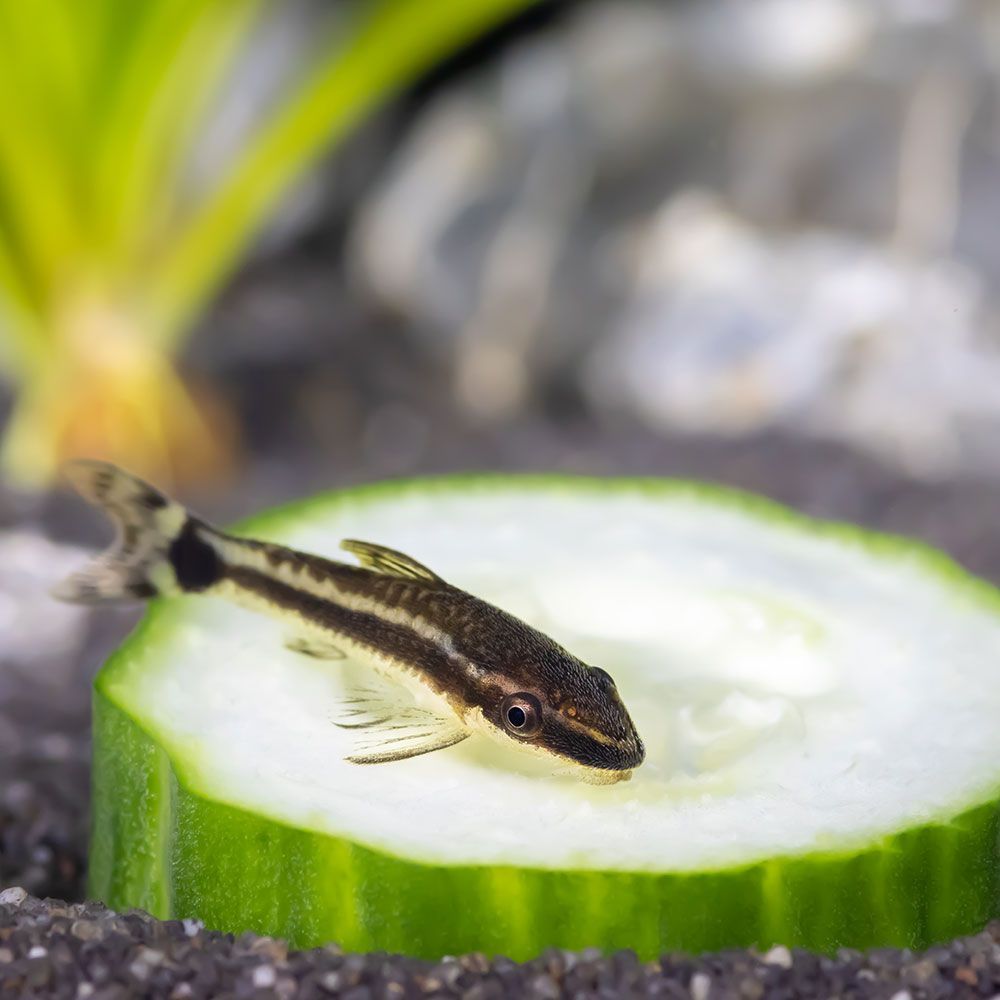If you’re planning to add a zero-fuss fish to your tank, the otocinclus catfish will be a fine choice.
This delightful dwarf fish is inexpensive, so that you can bag a group of them at once. It is a glutton for algae which is a bonus for aquarists.
If you’re ready to befriend this species, let’s get going!
What is an Overview of Otocinclus Catfish?
| Origin | Xingu, Tocantins, Paraguay, Parana, and Orinoco Rivers, Amazon basins, South America |
| Order | Siluriformes |
| Family | Loricariidae |
| Scientific Name | Otocinclus vittatus |
| Common Names | Dwarf Suckermouth Catfish, Dwarf Sucker, Oto |
| L Number | LDA023 |
| IUCN Red List Status | Not Evaluated |
| Appearance | Slim body with black back and silver or creamy belly |
| Size | Up to 4.2 cm (1.65 in) |
| Lifespan | 3-5 years in captivity, up to 10 years in wild |
| Temperament | Peaceful, friendly, shy |
| Tank Level | Bottom dwellers |
| Water Temperature | 68-77 °F (20-25 °C) |
| pH Level | 5.8-7.5 |
| Water Hardness | 2-18 |
| Care Level | Easy to Intermediate |
| Minimum Tank Size | 25 gallons for 6 of them |
| Tank Environment | Highly vegetated, spacious mature tank with algae growth |
| Diet | Primarily herbivorous |
| Tank Mates | Own school, other dull-colored, similar-sized or smaller, and peaceful species |
Which family does Otocinclus Catfish belong?
The Otocinclus genus belongs to the Hypoptopomatini tribe and subfamily Hypoptopomatinae of the Loricariidae family under the Siluriformes order.
Native to South America, the genus has been widespread throughout Eastern Andes, Northern Venezuela, and Northern Argentina,
All members of this genus are referred to by various names like Dwarf Suckermouth, Dwarf Sucking Catfish, Midget Sucker Fish, Otos/Ottos, and Oto Cat.
The terms “dwarf” and “midget” are used in their name due to their small size range, i.e., 2.4-5.5 cm (0.95-2.17 in) compared to other armored catfish genera.
Like other armored catfish species, they also have suckermouths on the underside and armor-plated bodies. They are also popular for eating algae.
While this think-piece will specifically discuss the species Otocinclus vittatus, let’s briefly know about other equally intriguing species of this genus!
Fun Fact: The fish is majorly marketed as a peaceful and small algae eater or “tank cleaner.” But it can only feast on softer algae and not all algae types.
What are the Types of Otocinclus Genus Fish?
Till now, 19 recognized species belong to the genus.
1. Silver Oto (Otocinclus vestitus)
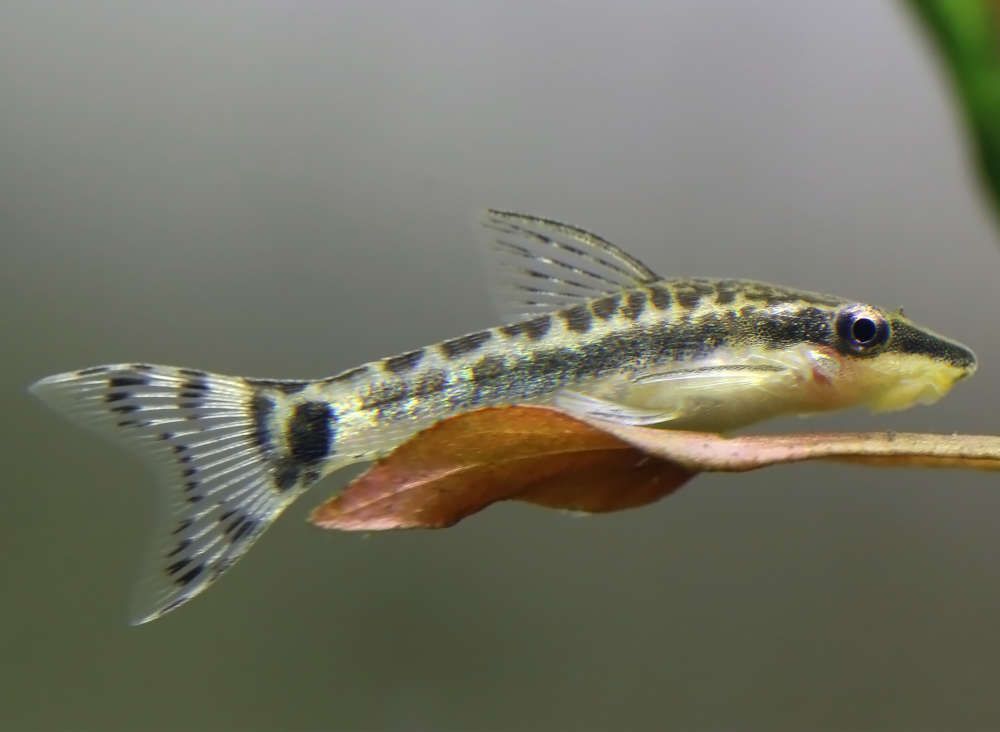
- Natural Habitat: Parana River basins, La Plata River, River Ambyiacu tributaries, Peru, South America
- Size: Up to 3.2 cm (1.26 in)
- Lifespan: Up to 3-5 years
- Tank Level: Bottom dwellers
- Temperament: Peaceful
- Diet: Herbivorous
- Tank Mates: Own school, extremely peaceful species
- Minimum Tank Size: 20-25 gallons for 6
Otocinclus vestitus is the type species of genus Otocinclus.
How to identify Silver Oto?
At one glance, it looks just like the common oto (Otocinclus vittatus) and is even mistakenly sold as that. However, it has a mottled appearance.
The sIlver oto has a horizontal black band that extends to its tail fin, but the band isn’t big enough to call it a blotch. Its mottled pattern is adjacent to the black band, and there’s no proper white band.
On the other hand, the upper edge of the common oto’s horizontal black band has a clear white band. This white band separates the black from the mottled pattern.
They eat all algae other than hair or green spot algae.
2. Dwarf Oto (Otocinclus macrospilus)
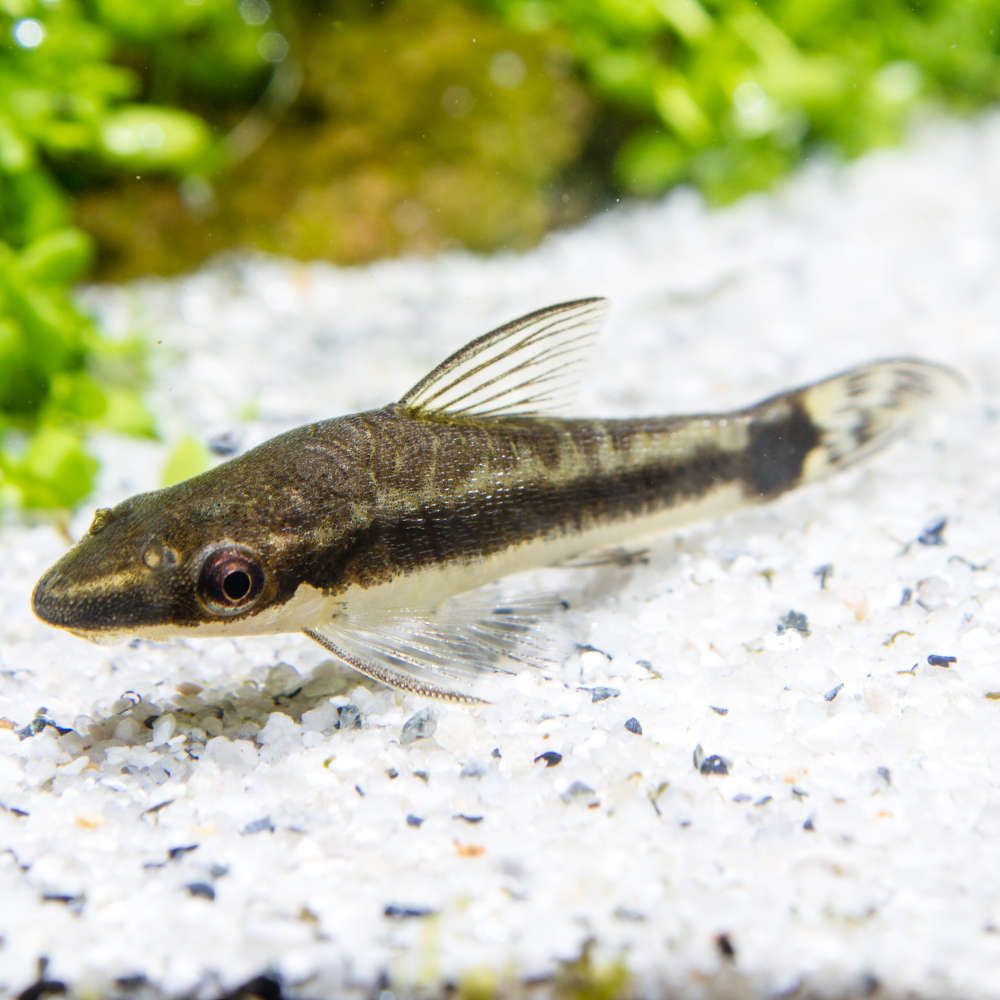
- Natural Habitat: River Morona and River Pintuyacu of Upper Amazon Basins, Ecuador, Colombia, and Peru, South America
- IUCN Red List Status: Least Concern, 2014 Assessment
- Size: Up to 3.4 cm (1.3 in)
- Lifespan: Around 7 years
- Tank Level: Bottom dwellers
- Temperament: Peaceful
- Diet: Primarily herbivorous, accepts omnivorous feed
- Tank Mates: Own school, other smaller and peaceful characins, corydoras, and cichlids
- Minimum Tank Size: 20 gallons for 6
How to identify a Dwarf Oto?
It has a dark back and a shiny silver-white underside. It looks much like the silver and common otos. But the only difference is that this one has a large round dark blotch on the tail fin, and its white band isn’t that distinct.
3. Zebra Otocinclus (Otocinclus Cocama)
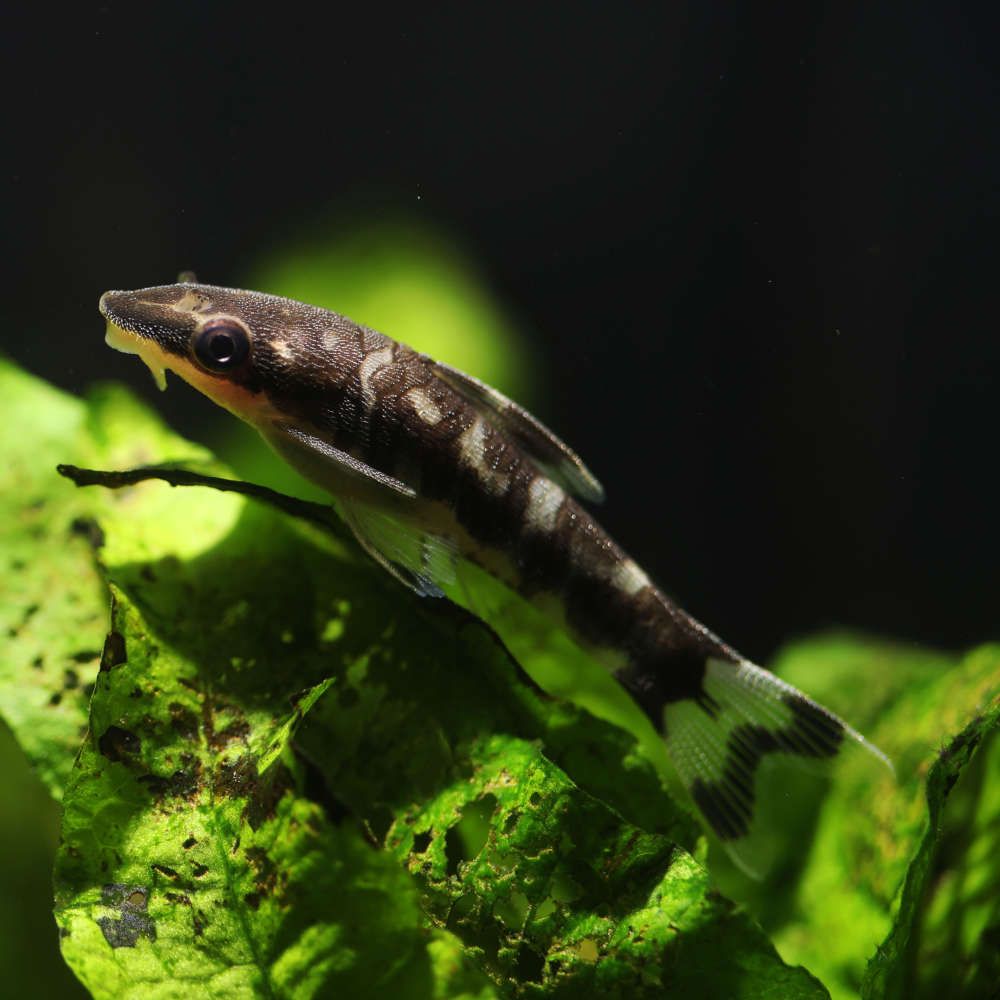
- Natural Habitat: River Maranon and River Ucayali, Ucayali Basins, Perou, South America
- IUCN Red List Status: Endangered, 2014 assessment
- Size: 4.4 cm (1.7 in)
- Lifespan: Up to 5 years
- Tank Level: Bottom dwellers
- Temperament: Peaceful
- Diet: Herbivorous
- Tank Mates: Only its own shoal, or extremely calm and much smaller characids
- Minimum Tank Size: 25 gallons for 6
How to identify a Zebra Oto?
Zebra otos can be easily identified due to their distinct coloration. The top of their head and the region between the nostrils are black. The ventral side of the head is yellowish-white.
Their black body has irregularly V-shaped bluish-white patterns, which makes them seem like zebras.
On their back, there are exactly 4 dark bands:
- The first band is at the beginning of the dorsal fin
- The second band is behind the dorsal fin
- The third band is between the dorsal fin and fluke fins
- The last band is at the beginning of fluke
There’s also a prominent black band on the tail, along with a W-shaped vertical stripe on the fluke fin.
While the fish adapts to a new environment, they only feed on biofilm and don’t accept other feed.
4. Golden Oto (Otocinclus Affinis)
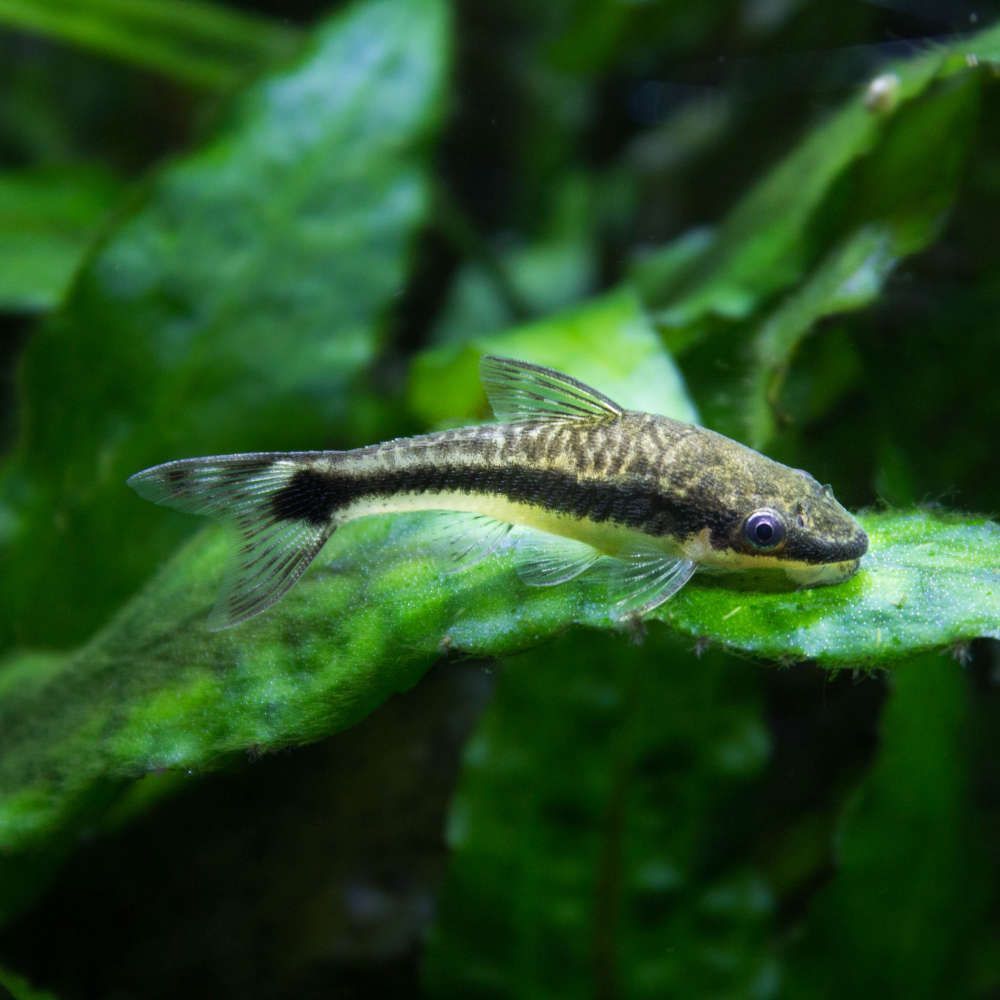
- Natural Habitat: Rio de Janeiro, Brazil, South America
- IUCN Red List Status: Least Concern, 2018 Assessment
- Size: 5 cm (2 in)
- Lifespan: Up to 8 years
- Tank Level: Bottom to middle dwellers
- Temperament: Peaceful, social, nocturnal
- Diet: Primarily herbivorous, accepts omnivorous feed
- Tank Mates: School of 6, other similar and smaller-sized peaceful species
- Minimum Tank Size: 25 gallons for 6
How to identify a Golden Oto?
Golden otos have a dark brown back and a creamy silver belly. On both of their sides, faint golden stripes can be seen. All fins are transparent with a tinge of brown.
What is the Natural Habitat of Otocinclus Vittatus?
The common oto is native to multiple South American River basins – Xingu, Tocantins, Parana, Paraguay, Amazon, and Orinoco.
It is frequently found in the countries Bolivia, Brazil, and Paraguay. However, some are also rarely found in the La Plata River basins, Argentina, and Peru.
Like all otos, this one prefers to swim in slow-moving oxygenated waters near large roots at 0-2m depths. This environment is usually more common on the river banks.
How does Otocinclus Catfish look?
Many of the Otocinclus genus members look much like the common oto. But little details can help you identify the species perfectly, so let’s get on with it!
What is the Size of Otocinclus Catfish?
This adult suckerfish grows up to as long as 4.2 cm (1.65 in).
What is the Color of Otocinclus Catfish?
This species has a greenish-grey backside and a creamy-beige underside. The color of the backside is darkest near the head and slowly fades away towards the tail.
This dark stripe continues on to its tail fin. There’s also a dark patch on the caudal peduncle.
What are the Features of Otocinclus Catfish?
The small slim, and streamlined fish has beady and slightly protruding eyes. The downward-facing mouth helps it suck onto flat surfaces like leaves and stones and hang/float onto them.
It also doesn’t have scales and only a bony armor plating or scutes.
How does a male and a female Otocinclus Catfish differ?
When observed from above, the female seems rounder than the male. There is no other way to differentiate the gender of fish from this genus.
What is the Behavior of Otocinclus Catfish in the tank?
The fish is not territorial about its area. Instead, it is timid, peaceful, and friendly. It is shy and stays with its shoal when stressed, while sleeping, or during feeds.
What is the Lifespan of Otocinclus Catfish?
The captivity-bred specimens can only last 3-5 years. However, in its natural habitat, the friendly fish can live for up to 10 years.
Authors Note: Add this species to a minimum of a 3-month-old tank to ensure there is enough algae to feed on.
How to take care of Otocinclus Catfish?

If you’re planning to house the fish, prepare the basics with these steps!
What is the recommended Tank Size for Otocinclus Catfish?
Group maintenance is vital for the excellent health and sustenance of this fish. So, for a group of 6, a tank of 25 gallons will suffice.
However, if you want to build a community tank, go bigger.
What is the Water Chemistry for Otocinclus Catfish?
Water parameters can affect these species a lot. So, make sure to maintain these levels strictly:
- pH Levels: 5.8-7.5
- Water Temperature: 68-77 °F (20-25 °C)
- Water Hardness: 2-18
- Ammonia: 0 ppm
- Nitrite: 0 ppm
- Nitrate: Below 20 ppm
What is the Tank Environment for Otocinclus Catfish?
But swimming space and good water conditions aren’t enough to keep your oto kicking. So, here are some more things you must consider!
Which Substrate to use for Otocinclus Catfish?
Always use soft and fine sand for your tank substrate. Since the otocinclus is a bottom dweller, this will protect it from getting hurt while grazing the tank bed.
Which Plants to use for Otocinclus Catfish?
Add large leafy plants like Anubius, Cabomba, Cryptocorynes, Java ferns, and Echinorous to the tank. Make it dense enough so it doesn’t obstruct their swimming space.
Don’t worry; the algae-eating fish won’t attack your healthy greens. Instead, it will feed on the algae on your plants.
However, avoid fast-growing plants as they consume nutrients too fast for algae growth.
Which Lighting to use for Otocinclus Catfish?
The timid dwarf sucker prefers dim lighting, as bright spaces make it insecure about being spotted by predators. You can also use floating plants to disperse the light further.
Which Décor is suitable for Otocinclus Catfish?
Use wood, rock structures, branches, or PVC pipes to create enough hiding space for each of your otocinclus. But be careful not to add any sharp items.
You can also add vertical flat rocks to help them hide behind.
Which Filter to use for Otocinclus Catfish?
Use a strong oxygenating filter to ensure a healthy environment for your pet fish.
What is the Water Flow Rate for Otocinclus Catfish?
To keep the fish most comfortable, use a slow to medium water flow rate.
Fish Care Tip: Always be alert about temperature changes in the summer. This fish cannot stand temperatures over 82 °F (28 °C).
What does Otocinclus Catfish eat?
Tank algae are not enough to fill your oto. Since the timid fish is primarily herbivorous, raise it on the following diet:
- Algae wafers
- Spirulina pellets
- Sinking pellets – since they don’t usually come to the surface
- Spinach
- Lettuce
- Cucumber
- Zucchini
- Any other green vegetable available
Once a week or two, feed it carnivorous feed like:
- Shrimp
- Tubifex
- Mosquito larvae
Feeding Tip: Don’t feed it a carnivorous diet more than once a week. Otherwise, it will cause intestinal obstruction, and the fish won’t be able to digest algae. Moreover, ensure you don’t overfeed it, and always clean any leftovers in the tank.
What are the Tank Mates for Otocinclus Catfish?
Otos often mind their own business and overlook other species unless they feel insecure. So, they can be great for most peaceful community tanks. But before you add tank mates, make sure you keep them in a minimum group of 6.
After that, any medium or smaller-sized peaceful and slow fish can be added. Some great tank mates are:
- Corydoras (but make sure that they don’t steal your otos’ food)
- Rasboras
- Dwarf gouramis
- Electric blue rams
- Small tetras (ember tetras)
- Golden wonder killifish
- Shrimps
- Snails
Which Tank Mates to Avoid for Otocinclus Catfish?
Avoid any fish that swims too fast, is excessively active, and is playful. Otherwise, they will stress out your oto leading to fatal situations.
So, here are examples of some species to be avoided:
- Goldfish
- Cichlid
- Oscar
- Jack Dempsey
- Pleco
- Ancistrus
What are the Common Diseases in Otocinclus Catfish?
Otocinclus species, including the common oto, can resist most diseases. However, you must be wary of some common diseases like these:
| Disease Name | Causes | Symptoms | Treatment |
|---|---|---|---|
| Ich | Protozoan parasite | White marks, flashing, appetite loss, inactivity | Add ich medicine, elevate aquarium temperature |
| Fin Rot | Bacterial infection | Frayed or disintegrated fins, discoloration or redness or fins, appetite loss, inactivity | Improve water quality, remove physically injurious objects, add medicines |
| Columnaris | Bacterial infection | Greyish or white patches, frayed fins, appetite loss, inactivity | Improve water quality, reduce stressors, add medicines |
| Dropsy | Infection, stress, bad water quality | Bloated belly, ulcers, redness on the skin near vents and fins | Quarantine, improve diet, more frequent water changes, add medicines |
Things to keep in mind:
- Always be ready with test kits, as this sensitive fish gets sick mostly due to unsteady water parameters.
- Avoid using potassium permanganate or copper salts as medicine, as the fish doesn’t have scales. Malachite green is a great option, but it’s better to speak to an expert.
How to breed Otocinclus Catfish in an aquarium?
The common otto breeds easily in the wild, but it’s quite hard in captivity. However, you can still try inducing the process in your tank by replicating the necessary conditions.
1. Tank Preparation
Use a separate tank of 25 gallons and set it up with enough big leafy plants. The fish can deposit the eggs on them.
Set water chemistry at the following:
- Temperature: 73 °F (23 °C)
- pH Level: 6.5
- Water Hardness: 2-9 dGH
You must also feed your fish nutritious food to prepare them.
2. Introduction & Induction
Introduce 3 males and 2 females in the tank. The cooler water temperature will trigger the fish to spawn.
If the process is successful, a pair will assume the “T” position and each female fish will lay 40-50 eggs on the glass tank or plant leaves. The male fish follows her and fertilizes the eggs. Each egg is about a millimeter long.
3. Incubation & Fry Development
The eggs hatch in 2-4 days, depending on temperature conditions. Initially, the fry feed on bacteria and algae growth in the tank. But as soon as they are 1cm long, feed them plankton and spirulina.
Breeding Tip: After laying eggs, the parent fish neither protects the young fry nor eats it. So, if you don’t want to shift the adult fish from the tank, that’s completely fine.
How to buy Otocinclus Catfish?
- Choose the fish that has a pearly white belly and actively swims in the aquarium store.
- Avoid thin-looking specimens, as the fish doesn’t want to eat once it gets starved. The fatter the specimen, the better its chance of survival and adaptation!
- If you have the option, always go for tank-bred otos for better survival chances. But they are not easily found.
- Don’t invest if the fish has bloody marks.
- Ideally, the fish fins must have two pointed edges. But with stress, it’s normal to get damaged, aka rounded. However, be careful about fish with severely damaged fins.
- Don’t buy if the fish has been fed flake food all along.
A word from FishInAquarium
The friendly otocinclus catfish are great for highly vegetated community tanks and will thrive for years with the basic care requirements.
With that, hopefully, you got to know everything about housing the otos in your tank. So, if you are satisfied with all the information, don’t forget to forward this link to fellow enthusiasts. And if there’s any buzzing question, drop a mail, and we’ll take care of it!

